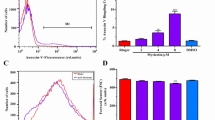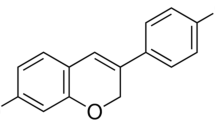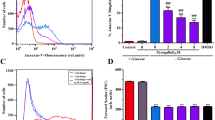Abstract
Environmental exposure to arsenic has been associated with anemia, which could result from suicidal erythrocyte death or eryptosis, characterized by cell shrinkage and phosphatidylserine exposure at the erythrocyte surface. Eryptosis is triggered by increase in cytosolic Ca2+ concentration, ceramide and energy depletion. The present experiments explored, whether arsenic stimulates eryptosis. According to annexin V-binding, arsenic trioxide (7 μM) within 48 h significantly increased phosphatidylserine exposure of human erythrocytes without inducing hemolysis. According to forward scatter, arsenic trioxide (7 μM) significantly decreased cell volume. Moreover, Fluo3-fluorescence showed that arsenic (10 μM) significantly increased cytosolic Ca2+ concentration. According to binding of respective fluorescent antibodies, arsenic trioxide (10 μM) significantly increased ceramide formation. Arsenic (10 μM) further lowered the intracellular ATP concentration. Removal of extracellular Ca2+ or inhibition of the Ca2+-permeable cation channels with amiloride blunted the effects of arsenic on annexin V-binding and cell shrinkage. In conclusion, arsenic triggers suicidal erythrocyte death by increasing cytosolic Ca2+ concentration, by stimulating the formation of ceramide and by decreasing ATP availability.







Similar content being viewed by others
References
Abdelghani AA, Anderson AC, Jaghabir M et al (1986) Arsenic levels in blood, urine, and hair of workers applying monosodium methanearsonate (MSMA). Arch Environ Health 41:163–169
Akel A, Hermle T, Niemoeller OM et al (2006) Stimulation of erythrocyte phosphatidylserine exposure by chlorpromazine. Eur J Pharmacol 532:11–17
Andrews DA, Low PS (1999) Role of red blood cells in thrombosis. Curr Opin Hematol 6:76–82
Bae ON, Lim KM, Noh JY et al (2007) Arsenite-enhanced procoagulant activity through phosphatidylserine exposure in platelets. Chem Res Toxicol 20:1760–1768
Bentzen PJ, Lang E, Lang F (2007) Curcumin induced suicidal erythrocyte death. Cell Physiol Biochem 19:153–164
Berg CP, Engels IH, Rothbart A et al (2001) Human mature red blood cells express caspase-3 and caspase-8, but are devoid of mitochondrial regulators of apoptosis. Cell Death Differ 8:1197–1206
Bieberich E, MacKinnon S, Silva J et al (2003) Regulation of cell death in mitotic neural progenitor cells by asymmetric distribution of prostate apoptosis response 4 (PAR-4) and simultaneous elevation of endogenous ceramide. J Cell Biol 162:469–479
Biswas D, Banerjee M, Sen G et al (2008) Mechanism of erythrocyte death in human population exposed to arsenic through drinking water. Toxicol Appl Pharmacol 230(1):57–66
Boas FE, Forman L, Beutler E (1998) Phosphatidylserine exposure and red cell viability in red cell aging and in hemolytic anemia. Proc Natl Acad Sci USA 95:3077–3081
Bookchin RM, Ortiz OE, Lew VL (1987) Activation of calcium-dependent potassium channels in deoxygenated sickled red cells. Prog Clin Biol Res 240:193–200
Bratosin D, Estaquier J, Petit F et al (2001) Programmed cell death in mature erythrocytes: a model for investigating death effector pathways operating in the absence of mitochondria. Cell Death Differ 8:1143–1156
Brugnara C, de Franceschi L, Alper SL (1993) Inhibition of Ca(2 +)-dependent K + transport and cell dehydration in sickle erythrocytes by clotrimazole and other imidazole derivatives. J Clin Invest 92:520–526
Cheng Y, Chang LW, Tsou TC (2006) Mitogen-activated protein kinases mediate arsenic-induced down-regulation of survivin in human lung adenocarcinoma cells. Arch Toxicol 80:310–318
Closse C, Dachary-Prigent J, Boisseau MR (1999) Phosphatidylserine-related adhesion of human erythrocytes to vascular endothelium. Br J Haematol 107:300–302
Conde P, Acosta-Saavedra LC, Goytia-Acevedo RC et al (2007) Sodium arsenite-induced inhibition of cell proliferation is related to inhibition of IL-2 mRNA expression in mouse activated T cells. Arch Toxicol 81:251–259
de la Fuente H, Portales-Perez D, Baranda L et al (2002) Effect of arsenic, cadmium and lead on the induction of apoptosis of normal human mononuclear cells. Clin Exp Immunol 129:69–77
Dekkers DW, Comfurius P, Bevers EM et al (2002) Comparison between Ca2+-induced scrambling of various fluorescently labelled lipid analogues in red blood cells. Biochem J 362:741–747
Fadok VA, Bratton DL, Rose DM et al (2000) A receptor for phosphatidylserine-specific clearance of apoptotic cells. Nature 405:85–90
Foller M, Shumilina E, Lam R et al (2007) Induction of suicidal erythrocyte death by listeriolysin from Listeria monocytogenes. Cell Physiol Biochem 20:1051–1060
Foller M, Geiger C, Mahmud H et al (2008) Stimulation of suicidal erythrocyte death by amantadine. Eur J Pharmacol 581:13–18
Gallagher PG, Chang SH, Rettig MP et al (2003) Altered erythrocyte endothelial adherence and membrane phospholipid asymmetry in hereditary hydrocytosis. Blood 101:4625–4627
Gonsebatt ME, Del Razo LM, Cerbon MA et al (2007) Arsenite induced oxidative damage in mouse liver is associated with increased cytokeratin 18 expression. Arch Toxicol 81:619–626
Grassme H, Bock J, Kun J et al (2002) Clustering of CD40 ligand is required to form a functional contact with CD40. J Biol Chem 277:30289–30299
Hebbel RP (1991) Beyond hemoglobin polymerization: the red blood cell membrane and sickle disease pathophysiology. Blood 77:214–237
Heck JE, Chen Y, Grann VR et al (2008) Arsenic exposure and anemia in Bangladesh: a population-based study. J Occup Environ Med 50:80–87
Kempe DS, Akel A, Lang PA et al (2007) Suicidal erythrocyte death in sepsis. J Mol Med 85:269–277
Kobayashi Y, Negishi T, Mizumura A, et al. (2007) Distribution and excretion of arsenic in cynomolgus monkey following repeated administration of diphenylarsinic acid. Arch Toxicol
Lang F, Lang KS, Lang PA et al (2006a) Mechanisms and significance of eryptosis. Antioxid Redox Signal 8:1183–1192
Lang PA, Beringer O, Nicolay JP et al (2006b) Suicidal death of erythrocytes in recurrent hemolytic uremic syndrome. J Mol Med 84:378–388
Lang PA, Huober J, Bachmann C et al (2006c) Stimulation of erythrocyte phosphatidylserine exposure by paclitaxel. Cell Physiol Biochem 18:151–164
Lang PA, Schenck M, Nicolay JP et al (2007) Liver cell death and anemia in Wilson disease involve acid sphingomyelinase and ceramide. Nat Med 13:164–170
Lui JC, Wong JW, Suen YK et al (2007) Cordycepin induced eryptosis in mouse erythrocytes through a Ca(2 +)-dependent pathway without caspase-3 activation. Arch Toxicol 81:859–865
Manna P, Sinha M, Sil PC (2008) Arsenic-induced oxidative myocardial injury: protective role of arjunolic acid. Arch Toxicol 82(3):137–149
Nicolay JP, Gatz S, Liebig G et al (2007) Amyloid induced suicidal erythrocyte death. Cell Physiol Biochem 19:175–184
Nicolay JP, Schneider J, Niemoeller OM et al (2006) Stimulation of suicidal erythrocyte death by methylglyoxal. Cell Physiol Biochem 18:223–232
Niemoeller OM, Akel A, Lang PA et al (2006a) Induction of eryptosis by cyclosporine. Naunyn Schmiedebergs Arch Pharmacol 374:41–49
Niemoeller OM, Kiedaisch V, Dreischer P et al (2006b) Stimulation of eryptosis by aluminium ions. Toxicol Appl Pharmacol 217:168–175
Schneider J, Nicolay JP, Foller M et al (2007) Suicidal erythrocyte death following cellular K+ loss. Cell Physiol Biochem 20:35–44
Shen Y, Shen ZX, Yan H et al (2001) Studies on the clinical efficacy and pharmacokinetics of low-dose arsenic trioxide in the treatment of relapsed acute promyelocytic leukemia: a comparison with conventional dosage. Leukemia 15:735–741
Shumilina E, Kiedaisch V, Akkel A et al (2006) Stimulation of suicidal erythrocyte death by lipoxygenase inhibitor Bay-Y5884. Cell Physiol Biochem 18:233–242
Wang ZG, Rivi R, Delva L et al (1998) Arsenic trioxide and melarsoprol induce programmed cell death in myeloid leukemia cell lines and function in a PML and PML-RARalpha independent manner. Blood 92:1497–1504
Wood BL, Gibson DF, Tait JF (1996) Increased erythrocyte phosphatidylserine exposure in sickle cell disease: flow-cytometric measurement and clinical associations. Blood 88:1873–1880
Woon LA, Holland JW, Kable EP et al (1999) Ca2+ sensitivity of phospholipid scrambling in human red cell ghosts. Cell Calcium 25:313–320
Wu MM, Chiou HY, Wang TW et al (2001) Association of blood arsenic levels with increased reactive oxidants and decreased antioxidant capacity in a human population of northeastern Taiwan. Environ Health Perspect 109:1011–1017
Acknowledgments
The authors acknowledge the technical assistance of E. Faber and the meticulous preparation of the manuscript by Tanja Loch. This study was supported by the Deutsche Forschungsgemeinschaft, Nr. La 315/4-3 and La 315/6-1. M. F. was supported by a grant from the Carl-Zeiss-Stiftung.
Author information
Authors and Affiliations
Corresponding author
Rights and permissions
About this article
Cite this article
Mahmud, H., Föller, M. & Lang, F. Arsenic-induced suicidal erythrocyte death. Arch Toxicol 83, 107–113 (2009). https://doi.org/10.1007/s00204-008-0338-2
Received:
Accepted:
Published:
Issue Date:
DOI: https://doi.org/10.1007/s00204-008-0338-2




